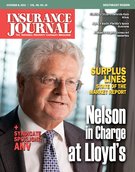Investments from the capital markets in various forms now provide around 14 percent of the total capital dedicated to providing reinsurance – approximately $35 billion [$17 billion in cat bonds] out of $250 billion.
The question remains whether this poses a threat to traditional reinsurers, or is more likely a complement that fulfills a need for their clients. Most specialists in the field consider capital market investments to be a useful adjunct to traditional reinsurance.
“It [funds from capital markets] will continue to grow as an attractive asset class,” said Adam Beatty, London-based managing director of Willis capital markets and advisory. “There’s lots of risk to invest in but it’s a complement as well as competition.”
His colleague, New York-based William Dubinsky, head of insurance linked securities, said the re/insurance industry “needs new strategies and more reinsurance capacity to address new risks, such as [contingent] business interruption from floods.”
Paul Schultz, CEO of Aon Benfield Securities, expressed the same opinion at the Reinsurance Rendezvous in Monte Carlo. The industry needs to embrace this new source of funding to become “more relevant to clients and offer more products,” he said.
While cat bonds are the most common form of insurance linked security (ILS), others created in recent years include collateral reinsurance, loss warranties and contingent capital.
These vehicles are often used when it’s impractical to go to a highly-rated reinsurer. “But the goal of assuring that the cedant gets paid [if a loss occurs] always remains our foremost concern,” said Beatty.
Employing an ILS is also a way to access the capital markets that doesn’t require establishing a reinsurance company. As such they have largely replaced the rapid formation of new reinsurers, which occurred after severe industry losses in the past, notably after Hurricane Andrew, Sept. 11 and the catastrophe losses in 2005.
Cat bonds, introduced by Swiss Re in 2001, have become common for reinsurers. Dubinsky said that they were “very complex at first, but they’ve really become pretty simple.”
As an example Willis, which acts as an intermediary, would employ a catastrophe modeling firm to assess the level(s) of risk, the capital required and other considerations. If the proposal is accepted, the bonds are constructed using the established risk parameters, and are then sold, sometimes through an investment bank, sometimes privately, to sophisticated investors. Unlike municipal bonds they are not registered for public sale. They are often set up outside of the U.S., particularly in Bermuda.
The main buyers of cat bonds were originally hedge funds but most are now placed with specialized mutual funds, pension funds or private placements. If there is a loss, it is paid to the cedant up to the amount of the bonds.This has happened but it is rare, and as cat bonds pay a healthy premium – well above current low interest rates – they are an attractive investment.
“Investors aren’t scared of them,” Dubinsky said, “especially since we have streamlined the process.”
Sidecars, a form of collateral reinsurance, offer a different type of ILS investment. These independent vehicles take on a portion of the quota share risk, which has been placed with a reinsurer. While the quota share exposure of the ceding reinsurer is unlimited, sidecars accept only a limited portion of that risk, some of which the reinsurer may have to take back, although Beatty said “the cedant usually doesn’t take it back.”
A sidecar gives a reinsurer greater leeway to accept risks since once the exposure has been transferred it is off of the reinsurer’s balance sheet, thereby strengthening its capital position and increasing capacity.
Contingent capital, a more recent development, is where investors agree to pay a certain amount to a corporation if a loss event occurs. This protects a company from an immediate ratings downgrade, which would result in greater borrowing costs, if the equity capital weren’t replaced. It could also act as a support for the company’s share price.
Insurance and reinsurance are, after all, about accepting risks and ILS markets offer new ways of doing so. “Catastrophe risks attract people who want to take risks,” Beatty said. “Cat bonds and the different products offered by the market cater to a different risk appetite.”
Added Dubinsky: “As the capital markets make more capital available, they also keep the cycle more level. We also need to develop solutions beyond natural catastrophes, going further into casualty and fires, etc. presents such an opportunity.”
Topics Catastrophe Reinsurance
Was this article valuable?
Here are more articles you may enjoy.


 Insurance Industry ‘Megadeals’ Dominate 2025, Says PwC
Insurance Industry ‘Megadeals’ Dominate 2025, Says PwC  AIG Partners With Amwins, Blackstone to Launch Lloyd’s Syndicate Using Palantir
AIG Partners With Amwins, Blackstone to Launch Lloyd’s Syndicate Using Palantir  North Carolina Sting Operation Alleges Roofer Damaged Shingles to File Claim
North Carolina Sting Operation Alleges Roofer Damaged Shingles to File Claim  Former CEO of Nonprofit P/C Statistical Agent Sentenced for Stealing Millions
Former CEO of Nonprofit P/C Statistical Agent Sentenced for Stealing Millions 


